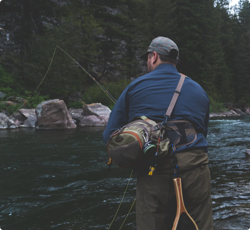
Outdoor Report 10/31
There was some decent salmon fishing on coastal rivers after the last rise in water we had, but rivers are again low and clear. Fish were caught back-bouncing roe, back-trolling sardine-wrapped plugs, bobber-fishing eggs and even some while old-school drift-fishing. We need more rain to draw another batch of fresh fish into rivers, and there should be another good push of both Coho and Chinook on the next rise. If river fishing is your favored venue, salmon are still available in deeper holes if you scale down your gear, offer smaller baits and concentrate on the heavy water at the head of the hole. Lower river levels mean that salmon will continue to stage in bays and tidewater awaiting the next freshet. In the bays, anglers are mostly trolling small spinners like Simon and VIP 3.5’s behind Pro Trolls, or other similar 360° flashers. Believe it or not, good old plain herring has also been catching fish! Fishermen have also been trolling in the tidewater reaches of rivers where possible, and bobber fishing eggs and sand shrimp is also a solid tactic for targeting fish here. Casting spinners in tidewater is also a sometimes effective way to wake up lethargic fish that aren’t responding to bait. A #5 Blue Fox Vibrax in chartreuse, copper or blue can be deadly for this at times. There are still some Coho available in local streams, but it looks like we are past the peak of the run in the Sandy and Clackamas. Look elsewhere for later B-run fish; some Southwest and coastal Washington streams have later runs of Coho. Float-fishing eggs, casting spinners or plugs and twitching jigs are all productive at times. Chum salmon have begun to trickle into their usual locations, but we’ll need more rain to draw in the herd. Be sure to check the regulations when targeting Chum, for they are catch-and-release only in many locations, and aren’t very good to eat once in rivers anyway. The cerise-colored Steelhead Scampi from local company, BnR Tackle, is absolutely killer for Chum wherever they are found. Fish it on a ¼-ounce jig head under a float and hang on! A minimum of twenty-pound gear is recommended for Chum as they are brutal fighters with pronounced teeth! The farther north you travel, the more prolific the runs become. Known as reckless biters when conditions are good, they can also be finicky when rivers are low and clear. In this situation, tipping your offering with cocktail shrimp or prawn meat can make all the difference. They are also suckers for drift gear and jigs in pink and chartreuse, and they will sometimes destroy your favorite Chinook plugs! Sturgeon fishing can be hit-and-miss this time of year, but if you keep on the move you can often locate willing biters. Having several different options for bait on board can also be critical for success. Herring, smelt, anchovy, and sand shrimp can all work at times, and even night crawlers can produce, especially on the Willamette River. Trout fishing can still be excellent this time of year, especially at low-elevation lakes that really shine as water temperatures continue to drop. Henry Hagg Lake near Forest Grove can be particularly productive as it continues to receive a large number of planted fish, with over 8,000 legal and trophy trout recently stocked there. In the cooler water of Fall, fishing bait becomes effective once again, and trolling or casting your favorite trout lures can also be deadly. When heading out trout fishing this time of year, be sure to check regulations for the water you intend to fish as many trout waters—including most rivers—close to trout fishing on October 31st. Crabbing has been great when the weather allows. Use up to three pots or rings per person to maximize your haul; limit 12 male crab per person on Dungeness. Type of bait can also be important, so it often pays to try different options to see what these tasty critters prefer on any given day. Please be safe when crabbing or fishing on our bays or ocean this time of year and keep a sharp eye on the weather! Razor clamming on Oregon Beaches is open and can be great on a good tide set. Most clammers focus on beaches north of Tillamook Head as populations there are more robust. Bay clams can be taken all along our Coast or Bays, and this is a great way to get the whole family involved in an outdoor activity in the awesome Pacific Northwest! Dress warm and take along a change of clothes as clamming can be a messy business! Minus tides provide the best access to these critters. Before heading out, it is advisable to call the Oregon Shellfish Hotline for any updates or closures: 1-800-448-2474. Always be sure to check local regulations at ODFW and WDFW before heading out. Find reports and two most widely used baits, information on the Fisherman's Community page.





